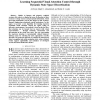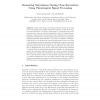261 search results - page 39 / 53 » Theory and Evaluation of Human Robot Interactions |
ATAL
2003
Springer
14 years 1 months ago
2003
Springer
This paper describes the implementation and evaluation of a framework for modeling emotions in complex, decision-making agents. Sponsored by U.S. Army Research Institute (ARI), th...
ICRA
2009
IEEE
14 years 2 months ago
2009
IEEE
² Similar to humans and primates, artificial creatures like robots are limited in terms of allocation of their resources to huge sensory and perceptual information. Serial process...
ICRA
2007
IEEE
14 years 2 months ago
2007
IEEE
— This paper proposes a simple passivity-based disturbance rejection scheme for force-controllable biped humanoids. The disturbance rejection by force control is useful not only ...
IEAAIE
2009
Springer
14 years 2 months ago
2009
Springer
Many researchers in the HRI and ECA domains try to build robots and agents that exhibit human-like behavior in real-world close encounter situations. One major requirement for comp...
CHI
2007
ACM
14 years 8 months ago
2007
ACM
The usability of Free/Libre/Open Source Software (FLOSS) is a new challenge for HCI professionals. Although HCI professionals are working on usability issues in FLOSS, the CHI com...



